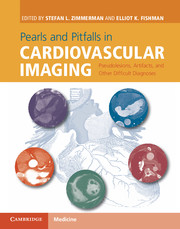 Pearls and Pitfalls in Cardiovascular Imaging
Pearls and Pitfalls in Cardiovascular Imaging from Section 2 - Cardiac aneurysms and diverticula
Published online by Cambridge University Press: 05 June 2015
Imaging description
Atrial septal aneurysms (ASA) appear as a thin-walled, round or lobulated outpouching located at the fossa ovalis. They are formed by redundant tissue of the fossa ovalis that protrudes ≥ 10–15 mm beyond the plane of the interatrial septum with a base ≥ 15 mm in width (Figure 18.1). ASAs bulge into either the left or right atrium depending upon the prevailing atrial pressure gradient and often have a “to-and-fro” motion throughout the cardiac cycle (Figure 18.2). Signal characteristics on imaging match the adjacent left or right atrial blood pool (Figure 18.3). For instance, if the aneurysm is protruding into the left atrium, signal characteristics will match the right atrial blood pool, and vice versa. Diagnosis is straightforward with echocardiography and cardiac MRI, given the ability to visualize the characteristic motion of the ASA during the cardiac cycle (Figure 18.4). Diagnosis can be challenging on enhanced CT examinations of the chest that use a saline chaser following the contrast bolus. The right atrium is low attenuation in these cases due to the saline flush. ASAs directed into the left atrium will appear as hypoattenuating masses in the enhanced left atrial blood pool (Figure 18.5). Conversely, septal aneurysms directed into the right atrium could be mistaken for a right atrial mass on acquisitions timed for the pulmonary arteries. Injection protocols that utilize dilute contrast in the second phase of the injection for opacification of right-sided heart structures are helpful to avoid this pitfall. In addition, if available, multiphase ECG-gated images are helpful to visualize the characteristic motion of septal aneurysms.
Importance
ASAs may be incorrectly mistaken for cardiac tumors, particularly atrial myxomas, during enhanced CT of the chest. Misdiagnosis or uncertainty in diagnosis can lead to unnecessary follow-up examinations, patient anxiety, or worse, inappropriate surgery. ASAs generally have a benign course; however, patients with ASA have an increased prevalence of patent foramen ovale, present in 50–70% cases (Figure 18.1), and cerebral ischemic events (stroke or transient ischemic attack).
To save this book to your Kindle, first ensure [email protected] is added to your Approved Personal Document E-mail List under your Personal Document Settings on the Manage Your Content and Devices page of your Amazon account. Then enter the ‘name’ part of your Kindle email address below. Find out more about saving to your Kindle.
Note you can select to save to either the @free.kindle.com or @kindle.com variations. ‘@free.kindle.com’ emails are free but can only be saved to your device when it is connected to wi-fi. ‘@kindle.com’ emails can be delivered even when you are not connected to wi-fi, but note that service fees apply.
Find out more about the Kindle Personal Document Service.
To save content items to your account, please confirm that you agree to abide by our usage policies. If this is the first time you use this feature, you will be asked to authorise Cambridge Core to connect with your account. Find out more about saving content to Dropbox.
To save content items to your account, please confirm that you agree to abide by our usage policies. If this is the first time you use this feature, you will be asked to authorise Cambridge Core to connect with your account. Find out more about saving content to Google Drive.